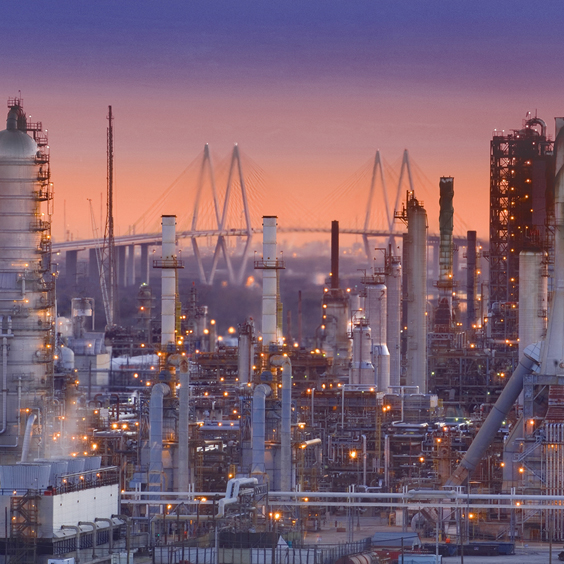Gasolines
Pyrolysis gasoline or Pygas is a naphtha-range product with a high aromatics content. It is a by-product of high temperature naphtha cracking during ethylene and propylene production. PyGas has high potential for use as a gasoline blending mixture and/or as a source of aromatics. Currently, PyGas is generally used as a gasoline blending mixture due to its high octane number. Pyrolysis gasoline can be blended with other hydrocarbons as a gasoline additive, or distilled (in BTX process) to separate it into its components, including benzene.
Petrol is a transparent, petroleum-derived liquid that is used primarily as a fuel in internal combustion engines. The characteristic of a particular gasoline blend to resist igniting too early (which causes knocking and reduces efficiency in reciprocating engines) is measured by its octane rating. Tetraethyllead and other lead compounds are no longer used in most areas to regulate and increase octane-rating, but many other additives are put into gasoline to improve its chemical stability, control corrosiveness and provide fuel system ‘cleaning,’ and determine performance characteristics under intended use. Sometimes, gasoline also contains ethanol as an alternative fuel, for economic or environmental reasons.
Gasoline A-85
| Properties | Unit | Specification | Test Method |
| Density @20 °C | g/cm3 | 0.725 Max | ASTM D 1298 |
| Color | Saybolt | Light/ Red, Yellow | – |
| Total Sulfur | ppm | 500 Max | ASTM D 4294 |
| Lead Content | ppb | 10 Max | A.A |
| IBP | °C | 35 Min | ASTM D 86 |
| FBP | °C | 210 Max | ASTM D 86 |
| Paraffin Naphthenes | %Wt | 40 Min | G.C |
| Aromatics | %Wt | 25 Max | G.C |
| Others | %Wt | 15 Max | G.C |
| RON | 85 Min | Infrared |
Download PDF
Gasoline A-92
| Properties | Unit | Specification | Test Method |
| Density@ 20 °C | g/ml | 0.755 Max | ASTM D 1298 |
| Color | Saybolt | Light Red/Yellow | – |
| Total Sulfur | ppm | 100 Max | ASTM D 4294 |
| Lead Content | ppb | 10 Max | A.A |
| IBP | °C | 35 Min | ASTM D 86 |
| FBP | °C | 210 Max | ASTM D 86 |
| Paraffin Naphthenes | %Wt | 30 Min | G.C |
| Aromatics | %Wt | 35 Max | G.C |
| Benzene | %Wt | 1 Max | G.C |
| Others | %Wt | 15 Max | G.C |
| RON | 92 Min | Infrared | |
| MON | 84 Min | Infrared |
Download PDF
| Properties | Unit | Result | Expected | Test Method |
| Density @15°C | g/cm3 | 0.7391 | 710 min – 780 max | ASTM D 1298 |
| RON | 95.2 | 95 min | ASTM D 2699 | |
| MON | 85.2 | 85 min | ASTN D 2700 | |
| RVP @ 37.8°C | kPa | 63.2 | 49 min – 83 max | ASTM D 323 |
| Distillation, 10% vol. recovered | °C | 50.3 | 74 max | ASTM D 86 |
| Distillation, 50% vol. recovered | °C | 82.2 | 127 max | ASTM D 86 |
| Distillation, 90% vol. recovered | °C | 167.1 | 190 max | ASTM D 86 |
| FBP | °C | 202.6 | 225 max | ASTM D 86 |
| Olefins Content | %Vol | 9.5 | 26 max | ASTM D 1319 |
| Aromatics Content | %Vol | 26.7 | 35 max | ASTM D 5580 |
| Benzene Content | %Vol | 0.64 | 1 max | ASTM D 5580 |
| Oxygenates (MTBE) | %Vol | 12.9 | 15 max | ASTM D 4815 |
| Total Sulfur Content | ppm | 11 | 150 max | ASTM D 5453 |
| Lead content | g/L | <0.0025 | Nil | ASTN D 3237 |
| Color | Undyed | Report | Visual |
Download PDF
Dry Pyrolysis Gasoline (DPG)
| Properties | Unit | Result | Expected | Test Method |
| Density @15.6 °C | g/cm3 | 0.85 | 0.9 Max | ASTM D 4052 |
| RVP | psi | 6.5 | Report | ASTM D 323 |
| Total Sulfur | ppm | 180 | Report | ASTM D 5453 |
| IBP | °C | 38 | Report | ASTM D 86 |
| FBP | °C | 185 | Report | ASTM D 86 |
| 5% Vol Recovered | °C | 51 | Report | ASTM D 86 |
| 95% Vol Recovered | °C | 177 | Report | ASTM D 86 |
| Paraffin | %Wt | 2.1 | Max 3 | G.C |
| Olefins | %Wt | 24.5 | Max 30 | G.C |
| Naphthenes | %Wt | 0.4 | Max 0.6 | G.C |
| Aromatics | %Wt | 66.4 | 60 Min | G.C |
| Others | %Wt | 6.6 | 20 Max | G.C |
| Benzene Content | %Wt | 42.4 | 40 Min | G.C |
Download PDF
Hydrogenated Pyrolysis Gasoline (HPG)
| Properties | Unit | Specification | Test Method |
| Specific gravity @15°C | 0.78 – 0.84 | ASTM D 1298 | |
| Color | Saybolt | + 5 Min. | ASTM D 156 |
| RVP | psi | 5 – 12 | ASTM D 323 |
| IBP | °C | 34 Min. | ASTM D 86 |
| FBP | °C | 210 Max. | ASTM D 86 |
| Aromatics | %Wt | 50 Min. | By GC |
| Total Sulfur | ppm (wt) | 300 Max. | ASTM D 3120 |
| Copper Corrosion | No. 1a | ASTM D 130 | |
| Lead Content | ppb | 5 Max. | ATOMIC |






